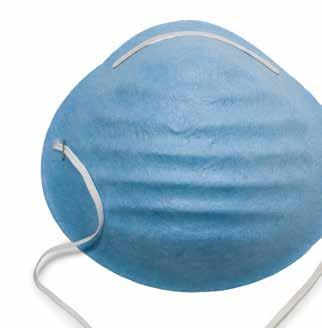
21 minute read
CORONAVIRUS: WHAT PHYSICIANS NEED TO KNOW
Coronavirus: What physicians need to know Communicable Disease Branch, Colorado Department of Public Health and Environment
The Centers for Disease Control and Prevention (CDC) is closely monitoring an outbreak caused by a novel (new) coronavirus (2019-nCoV) that was first identified in Wuhan City, Hubei Province, China in December 2019. Since then, more than 30,000 cases have been reported, with the vast majority in mainland China. While initially there was speculation of zoonotic transmission, the virus is now spreading between people, including from patients to health care workers. Person-to-person transmission has now occurred in the United States as well.
Advertisement
Coronaviruses are a family of viruses which includes SARS and MERS as well as a number of other common coronaviruses (including HKU1, 229E, NL63 and OC43) which circulate regularly in the United States and generally cause mild upper respiratory infections. Many patients are concerned when they test positive for coronavirus on a respiratory pathogen panel, but according to CDC, 2019-nCoV is not cross reactive with other coronaviruses on PCR panels such as Biofire (meaning if a person has 2019-nCoV they will not test positive for coronavirus on a commercial PCR test).
As of Feb. 6, 2020 there are 12 confirmed cases of 2019-nCoV in the United States, with cases in Arizona, California, Illinois, Massachusetts, Washington State and Wisconsin. There have been no confirmed cases in Colorado. The Colorado Department of Public Health and Environment (CDPHE) is asking providers to please contact us or your local public health agency (LPHA) about any patient with fever or respiratory symptoms who reports travel to China in the 14 days before they became ill. We will work with clinicians and patients to determine who needs to be tested for 2019-nCoV; currently CDC is requesting nasopharyngeal and oropharyngeal swabs be collected (details at https://
www.cdc.gov/coronavirus/2019-ncov/ lab/guidelines-clinical-specimens.html). All specimens are being sent to the CDPHE laboratory and then forwarded on to CDC for testing, although we anticipate that our state public health laboratory will have the capacity to test for 2019- nCoV within the next few weeks. In many situations, those who are identified as Patients Under Investigation (PUIs) who do not require hospitalization can be self-isolated at home while results are pending, but public health will make this determination on a case-by-case basis.
When evaluating a patient with suspected 2019-nCoV, the patient should be masked immediately and moved to a private room with the door closed; an airborne infection isolation room (AIIR) should be utilized if available. If an AIIR is not available, place a facemask on the patient and isolate him/her in an examination room with the door closed. Ideally, the patient should not be placed in any room where room exhaust is recirculated within the building without HEPA filtration. Health care providers should follow standard contact and airborne precautions with eye protection (e.g. isolation gown, fit tested N-95 or higher respirator, gloves and eye protection or full face shield) while in the examination room. Personal protective equipment (PPE) should be

donned prior to entering the patient room and should be disposed of immediately upon exiting. PPE should not be worn for care of more than one patient. Collecting diagnostic respiratory specimens (e.g. nasopharyngeal swabs) may induce coughing or sneezing and requires the use of PPE as described above. Individuals in the room during the procedure should, ideally, be limited to the patient and the health care provider obtaining the specimen. Patients who require hospitalization should be transferred as soon as is feasible to a facility where AIIR is available. If the patient does not require hospitalization they can be discharged to home (in consultation with state or local public health authorities) if deemed medically and socially appropriate.
• CDC’s Clinician Outreach and Communication Activity (COCA) webinars on 2019-nCoV are posted at the following website: https://emergency.cdc.gov/ coca/calls/2020/callinfo_013120.asp. The recording of the most recent call from Jan. 31, 2020 is available to watch. • Make sure you are registered to receive CDPHE’s Health Alert Network (HAN) broadcasts. This is where you will find the most updated information on PUI definitions, how to report to public health, and other communications about 2019-nCoV. If you do not currently receive HANs, please email cdphe_epr_sit@state.co.us with your full name, position and county of employment to sign up. • C D P H E ’s 20 1 9 - n C oV we b si te: https://www.colorado.gov/pacific/ cdphe/2019-novel-coronavirus.
• CDC’s 2019-nCoV website for health care professionals: https://www.cdc. gov/coronavirus/2019-nCoV/hcp/ index.html.
This is not a comprehensive list of recommendations for preventing transmission of 2019-nCoV in health care settings. You can find and review the most current detailed interim infection prevention recommendations for health care settings at the following webpage: https://www.colorado.gov/pacific/cdphe/ resources-local-public-health-agenciesand-healthcare-providers. Clinicians or infection preventionists can use our Initial Assessment Form to collect information to help determine if the patient is at risk for 2019-nCoV (https:// drive.google.com/file/d/1wapi65VeNUx 6KA3OsrPfJZ6ATe1U9y-N/view).
Treatment for 2019-nCoV is primarily symptomatic; in some cases, investigational antivirals may be available through CDC but it is unknown at this time whether they might be effective. CDC has noted that in the case of MERS, use of steroids was associated with delayed clearance of the virus (https://www.ncbi.nlm.nih. gov/pubmed/29161116), and has therefore stated that clinicians may wish to avoid steroids unless they are clearly indicated (for example for underlying COPD or in the case of refractory septic shock).
Report a case or questions:
To report a case of 2019-nCoV or if
you have any questions about our
guidance, please contact CDPHE or
your local health department. You can
reach an epidemiologist at CDPHE
who works on 2019-nCoV by calling
303-692-2700 or 303-370-9395.
Colorado Based Colorado Focused
NMLS#1818094
ServingColorado's MedicalCommunitywith aLoanProgramSpecific forDoctors
Doctorscanfaceuniquechallengeswhenit comestohomeloanfinancing.TheDoctorLoan ProgramatZenitheasesthefinancialrestrictions thatcommonlyimpedesborrowing.





















5%down Financing upto$2,000,000
Allowsexclusionofstudentloandebt Optionswithnomortgageinsurance

Cadaver lab Kaitlyn Brunworth
Kaitlyn Brunworth is a third-year medical student at the University of Colorado. Prior to medical school, Kaitlyn played NCAA Division II soccer for Wingate University in Charlotte, N.C. Her other hobbies include rafting, hiking, skiing and traveling with friends and family. Next year she plans to match in physical medicine and rehabilitation.
A body once full, A spirit now full.
hollowed out. One structure at a time. The epidermis peeled back, then superficial fascia. A muscle transected, reflected. A vein stripped, removed. Lifeblood will never return to the heart. Eyes as bright as her brand-new white coat.
May she not be hollowed out,
one day at a time.
Countless hours of memorization,
late nights,
early mornings,
frustrating patients,
tough teachers,
a lack of reflection.
May her hope not be stripped.
May the lifeblood return to her heart,
and remind her of why she began. ■
Reflective writing is an important component of the CU School of Medicine curriculum. Beginning in the first semester, medical students write essays, stories or poetry that reflect what they have seen, heard and felt. Reflections is edited by Steven Lowenstein, MD, MPH, and Tess Jones, PhD. It is dedicated to the memory of Henry Claman, MD, Distinguished Professor of the University of Colorado, founder of the Arts and Humanities in Healthcare Program, and original co-editor of this column.

BCMS hosts “Legislation 2020” to bring together local legislators and doctors
From left: Contract lobbyists Dan Jablan and Jerry Johnson; Rep. Kyle Mullica; Rep. Jonathan Singer; Rep. Yadira Caraveo; Rep. Edie Hooton; and BCMS President Todd Mydler, MD.

The Boulder County Medical Society hosted a legislative night on Feb. 4, 2020,
to facilitate conversations between physicians and legislators on top health
policy issues under consideration by the 2020 Colorado General Assembly.
Elected officials in attendance were Rep. Edie Hooton (D-Boulder), moderat
ing the panel discussion; Rep. Jonathan Singer (D-Longmont), addressing the
opioid epidemic; Rep. Kyle Mullica (D-Thornton), discussing vaccination rates
and firearm safety; and Rep. Yadira Caraveo, MD, (D-Thornton) addressing the
use of e-cigarette and vaping devices among youth. Physicians in attendance
asked questions about physician advocacy and engagement. Honored guests
included CMS contract lobbyists Jerry Johnson and Dan Jablan, CMS CEO
Bryan Campbell and CMS COO Dean Holzkamp. The event was coordinated by
BCMS Executive Director Judy Ladd and BCMS President Todd Mydler, MD. ■
DEPARTMENTS MEDICAL NEWS
Colleagues and friends gathered to wish outgoing CMS CEO well in his retirement
Physicians and friends from around Colorado gathered at Colorado Medical Society head
quarters on Jan. 30 to congratulate outgoing CEO Alfred Gilchrist on his retirement. Gilchrist
was presented with the CMS Lifetime Achievement Award and, as an avid golfer, a set
of personalized golf clubs. CMS will honor his legacy with the Alfred D. Gilchrist Student
Leadership Scholarship, to be awarded starting in 2020. ■
DEPARTMENTS MEDICAL NEWS
COPIC promotes members of its management team to senior vice presidents
COPIC has announced that five members of the company’s management team were recently promoted to senior vice president positions. The promotions include the following:
Kristin Stepien Senior Vice President, Sales and Business Development
Janel Loud-Mahany Senior Vice President, Underwriting and Policyholder Services
Beverly Razon Senior Vice President, Public Affairs
Shelly Waggoner Senior Vice President, Human Resources
Sean Gelsey Senior Vice President, Claims and Strategic Partnerships The promotions are part of COPIC adjusting its organizational structure to better meet the needs of our insureds as well as to address market expansion and manage growing business operations. Collectively, this group represents over 60 years of experience at COPIC and they are recognized as leading industry experts in their respective areas.
“A big factor in COPIC’s success is the internal leadership and
expertise we have at our company,” said Gerald Zarlengo,
MD, COPIC CEO. “These well-deserved promotions are in key
areas that support our growth and commitment to high-quality
customer service, and we feel that this will better position us to
evolve and meet the challenges that lie ahead.” ■

Practicing mindfulness to process tragedy Jeffrey Beach
Critical reflective writing holds a prominent place in the Medical Humanities curriculum at Rocky Vista University, College of Osteopathic
Medicine. Beginning in the first semester of Medical Ethics, students engage in critical reflection to explore their own assumptions and biases
and how their values impact their practice. This submission is selected and edited by Nicole Michels, PhD, chair of the Department of Medical
Humanities, and Alexis Horst, MA, writing center instructor.
Jeffrey Beach is from Rye, Colo., and attained his undergraduate education at Colorado State University - Pueblo. He has a passion for quality patient care and is considering anesthesiology for his future career. In his free time, he loves to hike any trail he can find, cook new and exciting recipes with his wife, and practice mindfulness through sitting quietly.
Obstetrics is a field in which the only certainty is uncertainty – at least that’s what my attending told me upon first introductions. I was just orienting at the hospital when I was told the schedule for the day included a planned fetal demise delivery. Though this didn’t hit me hard at the time, by the evening it would. By afternoon, lunch was calling, and I rode the elevator down teeming with knowledge of how to perform a new set of clinical skills. The elevator ride back up was quite a different story. I rode in the elevator knowing that the family sharing the ride with me was tearful not due to a newborn baby birth, but the upcoming delivery for a demise.
Initially, I didn’t think that I would be involved in such a case, but my preceptor asked me to join. There are no right words for a mother who lost her child before it was even born. I did my best to be present for the family. I was there to talk not about medicine but the human connection that we all shared. We discussed vacations, life lessons and even our favorite type of pie: hers was Key Lime. It was a long end to a first day, but it was an even rougher beginning to a month of uncertainty stewing in
me. Driving home, I began to feel anger about being involved with the case, which I then pushed into denial. I realized in the following days that if I simply did not think of the situation, I wouldn’t be saddened by the loss.
My denial worked: It gave me the presumed strength to make it to the next day, the next question, and the next patient. As the weeks went on, I began to notice subtle changes in my mood. I felt as though I was getting through the days, writing notes, seeing patients, but my satisfaction decreased. My next rotation was psychiatry. I didn’t fully understand the implications of the different types of therapies implemented in the clinic but I wanted to learn what to prescribe to help my future patients. The first week in, my preceptor asked if I wanted to participate in the mindfulness groups. This was just another task, another way to check a box, another thing that I needed to do.
Upon the first visit with the mindfulness group, I realized that this was not about just sitting in and listening to another lecture; instead it was about self-reflection and being engaged not just
in one’s own mind, but in personal growth. This personal growth
did not have to directly revolve around knowing the pathophys
iology of an endocrine disorder, but involved the simple act of
being present in life. Over the next few sessions, I began to
realize that I was no longer being present for patients because
I was walled off against those around me, and I was in denial
about the trauma I had seen the last month. Instead of taking
in the pain and working through it, I held onto the thought that
I needed to keep moving. Because I was reluctant to practice
wellness in my life, I may have done a disservice to the patients
I saw. Patients deserve the right to have a provider who is pres
ent and not, as I was, in denial of feelings surrounding patient
encounters. Even as medical students, we need to fight burnout.
Implementing wellness as students can make the difference
and help prevent the burnout I experienced in a mild form 1 . I
began to see mindfulness practices as a way to be aware of things happening in my own mind and body.
Had it not have been for my psychiatry rotation, I may not have been introduced to mindfulness. Through mindfulness, I was able to reexperience the pain of seeing the mother deliver and was able to be present with the thoughts and feelings I had around the situation. Despite never meeting this family before, I was in full denial. I avoided the thoughts, I was confused as to why I was present and I refused to try to cope. Since the mindfulness practices, I have come to accept the tragedy that occurred. I have worked each day in small bits of time to overcome the avoidance of the situation. With mindfulness, I have been able to delve deeper into my feelings and see that though I am under stress, feeling overwhelmed and inadequate, I am enough. What I am doing matters.
I believe that mindfulness and overall wellness checks are the
key to being the best patient advocate possible. I have found
through my limited mindfulness experience that the best way to
connect with patients is by being present. I want to be present
not just with patients, but with peers and with myself to avoid
the toxic grief and denial that is all too common. I felt alone and
abandoned months ago in my rotation, and I never want my
peers to feel the same. I feel as though it is my responsibility as
a future provider to help my peers with the support they may
need. In the future, with wellness and mindfulness exercises,
I can continue to fight burnout. Perhaps being mindful for me
today can be something as simple as enjoying a bit of Key Lime
pie. Through mindfulness, I am able to find new and better ways
to be in this world. ■
1. Minor L. How Medical Schools Can Better Fight Burnout. The Wall Street Journal; September 12, 2017; New York, United States.

An office condo or building is typically worth more than the practice.
Owning real estate creates an additional asset and future revenue stream.
Real estate is typically a practice’s second highest expense, so why not put that money toward future equity?
Contact me to discuss if owning your real estate is the right fit for you.
Healthcare is complicated.
At CARR, we make your real estate decisions easy.
DENVER METRO
Perry Bacalis 303.945.5270 perry.bacalis@carr.us
ADVANTAGE PARTNER
COPIC’s “Three Cs” for improving health care Gerald Zarlengo, MD, Chairman & CEO, COPIC Insurance Company
As our advocacy team was planning for 2020, a standard question came up, “How does COPIC support and improve health care outside the coverage and resources we provide our insureds?” Our answers meandered through long, detailed examples of legislative challenges and sharing our knowledge with other stakeholders throughout Colorado. Due to the complexity of health care, these responses went down a common path. People took the time to fully articulate our efforts, detailed the various obstacles and opportunities, and analyzed how they contribute to the overall good.
It was a good discussion, but it made me realize that the bigger challenge is distilling these complex ideas down to a straightforward explanation. After some back-and-forth that took this into consideration, we hit upon a simple description: COPIC’s external advocacy can be defined in the context of Three Cs – convening, collaborating and contributing.
CONVENING is about serving as a catalyst to connect diverse stakeholders who offer an array of perspectives. Getting the right people in the room is often the biggest challenge, but it is an essential step for examining an issue to better understand the different parts and to recognize how different interests can align or conflict with one another. This collective view generates insight and action beyond what occurs when individual organizations operate on their own.
COPIC’s wide network in health care allows us to bring together voices from physicians, nurses, medical specialty societies, rural health care experts, patient advocates, health care system executives, health insurance providers and more. While technology has enhanced our ability to converse remotely, face-to-face interactions are critical to remind us that even though we are more connected than ever, our views can often be more fragmented and not informed by the valuable perspectives of others.
COLLABORATING focuses on utilizing the strengths and resources of those who come together to move ideas forward and develop the best possible solutions. I’ll admit, the term “collaboration” is often thrown around loosely in health care without much attention given to what it actually means. A recent Harvard Business Review article1 noted, “One problem is that leaders think about collaboration too narrowly: as a value to cultivate but not a skill to teach.” I like this framing because it reminds us of the key skills needed to support effective collaboration: learn to listen (not just talk), practice empathy, be open to experimenting with others’ ideas, and allow judgment to give way to curiosity.
The article went on to say: “In successful collaborations, each person assumes that everyone else involved, regardless of background or title, is smart, caring and fully invested. That mindset makes participants want to understand why others have differing views, which allows them to have constructive conversations.” In health care, embracing this type of mindset is what will open us up to new, innovative thinking about how we address the challenges we face.
CONTRIBUTING refers to how we apply our expertise and experience to support our partners. COPIC stands in a unique position where the medical and legal worlds intersect. This provides us with access to information, such as claims data and best practices, that is valuable in identifying potential risks and allows us to develop programs or resources to address these. However, this value is dependent on how well we disseminate our insight throughout the health care community. Every day, COPIC’s medical and legal experts come together to solve problems that our insureds encounter. We continue to take the information from these situations, analyze it on a broader level, and determine how we can contribute to improved care by sharing what we know with others.
The Three Cs represent a simple way to describe the complex
work that COPIC and our partners engage in. It also represents
one of the things I enjoy most about my role at COPIC – being
able to see health care from a broader perspective. My view
has expanded to be about “connecting the pieces” and under
standing how decisions ripple through the health care system
and impact providers and patients. And when we work together,
the potential to accomplish great things moves from a lofty goal
to a tangible reality. ■
1. https://hbr.org/2019/11/cracking-the-code-of-sustained-collaboration

What is private mortgage insurance? Peter G. Garvin, Vice President, Business Development, Zenith Home Loans
The mortgage industry is full of different terms and numerous different types of insurance. We have the following types of insurance that appear in a mortgage transaction:
PROPERTY INSURANCE Usually the home and contents; protects the consumer against loss.
FHA INSURANCE Protects the lender from loss in the event the borrower(s) default.
PRIVATE MORTGAGE INSURANCE Protects the lender from loss in the event the borrower(s) default on conventional loans with less than 20 percent down.
This article will focus on the third type of Insurance listed above, private mortgage insurance (PMI).
When you get a conventional loan (not FHA or VA government backed loan) and you put down less than 20 percent, your lender will require you to purchase private mortgage insurance to protect the LENDER in the event that you default on the loan.
The lender charges an annual premium to help minimize the risk associated with a default by the borrower(s). This annual premium is broken into 12 monthly payments and becomes an additive to the PITI monthly payment that you make to your lender.
P: Principal I: Interest T: Taxes I: Insurance (homeowners)
ZENITH HOME LOANS FOR DOCTORS
You may request a cancellation of your private mortgage insurance policy once you reach 20 percent equity in your home. This is determined by subtracting your outstanding loan amount from the market value of your property. Also, private mortgage insurance is automatically cancelled when your loan balance reaches 78 percent of the original value of your home. There are exceptions to these rules and these exceptions relate to the loan balance, type of loan (conforming or high balance), and past performance on monthly payments and credit of the borrower(s).
In the last issue of Colorado Medicine, we mentioned our newly designed “doctor loan” to assist young medical professionals with obtaining financing for purchasing a new home or to refinance an existing property. We highlighted the benefits of this program (5 percent down, loan amounts to $2,000,000, 720 FICO score, allows for exclusion of student debt and other options with NO PRIVATE MORTGAGE INSURANCE). Private mortgage insurance is not cheap, and it adds another component to your monthly payment. The cost for obtaining PMI can range from 0.5 percent to 5 percent. So, if we do the math and break this down to a monthly amount, let’s use the following example. Let’s say that you borrow $150,000 and the PMI percentage cost is 1 percent. That would be an annual amount of $1,500 or $125 per month added to your PITI payment. Wouldn’t it be great to not have to pay this amount every month?
Some of this may seem a bit confusing and you should always sit down with an experienced loan officer and ask any questions that you may have about private mortgage insurance or any other components of the mortgage loan process.
Feel free to call me directly at 303-907-7835 and I will be
happy to answer your questions and personally introduce you
to one of my professional senior loan officers on my team. ■









